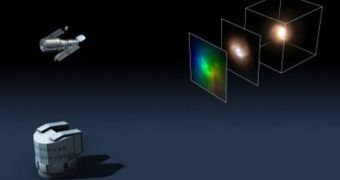Obtaining 3D views of galaxies has been something that even early astronomers wanted, as this type of images would give scientists large amounts of information to work with. They could identify trends in the motion of gases inside the formations, and could figure out exactly how the supermassive black holes at their centers influence these movements. Now, through a collaboration between NASA and the ESA European space agency, one of the most detailed 3D images of distant galaxies has become available. Hubble and the Very Large Telescope Array were both used for this photo.
When Hubble was first launched, in the early 1990s, it provided astronomers with never-before-met pictures of distant celestial bodies, and tiny specs of light that were before thought to be stars were revealed as galaxies, and carefully studied. One could say without mistaking that Hubble made one of the largest contribution to modern astronomy, a performance that cannot be replicated simply because this was the first real telescope in orbit, and it was used at its full potential.
On the other hand, the FLAMES/GIRAFFE spectrograph instrument on the the VLT is able to to observe and resolve up to 130 objects at a time, in an area of the sky spanning 25 arcmin in diameter. FLAMES stands for Fibre Large Array Multi Element Spectrograph, and is the main instrument, which also comprises the GIRAFFE subcomponent. Together, they are able to map the motions of gases in distant galaxies, and to offer predictions as to their future evolutions.
“This unique combination of Hubble and the VLT allows us to model distant galaxies almost as nicely as we can close ones. In effect, FLAMES/GIRAFFE now allows us to measure the velocity of the gas at various locations in these objects. This means that we can see how the gas is moving, which provides us with a three-dimensional view of galaxies halfway across the Universe,” explains the leader of the research team behind the new pictures, François Hammer.
“It is because we can now see how the gas is moving that we can trace back the mass and the orbits of the ancestral galaxies relatively accurately. Hubble and the VLT are real 'time machines' for probing the Universe's history,” adds Sébastien Peirani, who is the lead author of one of the papers reporting on the new achievements. “The next step will then be to compare this with closer galaxies, and so, piece together a picture of the evolution of galaxies over the past six to eight billion years, that is, over half the age of the Universe,” Hammer concludes.

 14 DAY TRIAL //
14 DAY TRIAL //